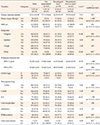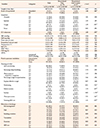1. Adeloye D, Chua S, Lee C, Basquill C, Papana A, Theodoratou E, et al. Global and regional estimates of COPD prevalence: systematic review and meta-analysis. Journal of Global Health. 2015; 5(2):020415. DOI:
10.7189/jogh.05.020415.

2. Mathers CD, Loncar D. Projections of global mortality and burden of disease from 2002 to 2030. PLOS Medicine. 2006; 3(11):e442. DOI:
10.1371/journal.pmed.0030442.

4. The Korean Academy of Tuberculosis and Respiratory Diseases. Revision committee of COPD medical guidline (2018 revision). Seoul: The Korean Academy of Tuberculosis and Respiratory Diseases;2018. p. 3.
5. Soltani A, Reid D, Wills K, Walters EH. Prospective outcomes in patients with acute exacerbations of chronic obstructive pulmonary disease presenting to hospital: a generalisable clinical audit. Internal Medicine Journal. 2015; 45(9):925–933. DOI:
10.1111/imj.12816.

6. Liu D, Peng S-H, Zhang J, Bai S-H, Liu H-X, Qu J-M. Prediction of short term re-exacerbation in patients with acute exacerbation of chronic obstructive pulmonary disease. International Journal of Chronic Obstructive Pulmonary Disease. 2015; 10(1):1265–1273. DOI:
10.2147/COPD.S83378.
7. Jeong SH, Lee H, Carriere KC, Shin SH, Moon SM, Jeong B-H, et al. Comorbidity as a contributor to frequent severe acute exacerbation in COPD patients. International Journal of Chronic Obstructive Pulmonary Disease. 2016; 11(1):1857–1865. DOI:
10.2147/copd.S103063.
8. Ringbæk T, Green A, Laursen LC, Frausing E, Brøndum E, Ulrik CS. Effect of tele health care on exacerbations and hospital admissions in patients with chronic obstructive pulmonary disease: a randomized clinical trial. International Journal of Chronic Obstructive Pulmonary Disease. 2015; 10(1):1801–1808. DOI:
10.2147/copd.S85596.
9. Gil E-H. Differences in adherence to self-care, drug compliance, and knowledge of heart failure based on rehospitalization of heart failure patients [master's thesis]. Daejeon: Eulji University;2013.
10. Wang L, Zang X-Y, Zhang Q, Liu S-Y, Shen Y-H, Zhao Y. Study on factors influencing recrudescent time of postdischarge patients with chronic obstructive pulmonary disease. Journal of Clinical Nursing. 2012; 21(11-12):1507–1514. DOI:
10.1111/j.1365-2702.2011.03899.x.

11. Choi Y-S. Comparison in nursing needs of heart disease patients depending on whether or not readmitted. Journal of Digital Convergence. 2014; 12(6):519–526. DOI:
10.14400/JDC.2014.12.6.519.

12. Kuo C-C, Lin C-C, Lin S-Y, Yang Y-H, Chang C-S, Chen C-H. Effects of self-regulation protocol on physiological and psychological measures in patients with chronic obstructive pulmonary disease. Journal of Clinical Nursing. 2013; 22(19-20):2800–2811. DOI:
10.1111/jocn.12085.

14. Lalmolda C, Coll-Fernández R, Martínez N, Baré M, Teixidó Colet M, Epelde F, et al. Effect of a rehabilitation-based chronic disease management program targeting severe COPD exacerbations on readmission patterns. International Journal of Chronic Obstructive Pulmonary Disease. 2017; 12:2531–2538. DOI:
10.2147/copd.S138451.

15. Koff PB, Jones RH, Cashman JM, Voelkel NF, Vandivier RW. Proactive integrated care improves quality of life in patients with COPD. European Respiratory Journal. 2009; 33(5):1031–1038. DOI:
10.1183/09031936.00063108.

16. Cho KH, Kim YS, Nam CM, Kim TH, Kim SJ, Han K-T, et al. Home oxygen therapy reduces risk of hospitalisation in patients with chronic obstructive pulmonary disease: a population-based retrospective cohort study, 2005-2012. BMJ Open. 2015; 5:e009065. DOI:
10.1136/bmjopen-2015-009065.

17. Kim KS, Yun EJ, Kim SY, Kim OS, So HS, Lee MS, et al. Medical surgical nursing. 8th ed. Seoul: Soomoonsa;2017. p. 654–663.
18. Gronkiewicz C, Borkgren-Okonek M. Acute exacerbation of COPD: nursing application of evidence-based guidelines. Critical Care Nursing Quarterly. 2004; 27(4):336–352.
19. Gregoriano C, Dieterle T, Breitenstein A-L, Dürr S, Baum A, Maier S, et al. Use and inhalation technique of inhaled medication in patients with asthma and COPD: data from a randomized controlled trial. Respiratory Research. 2018; 19:237. DOI:
10.1186/s12931-018-0936-3.

20. Vogelmeier CF, Criner GJ, Martínez FJ, Anzueto A, Barnes PJ, Bourbeau J, et al. Global strategy for the diagnosis, management, and prevention of chronic obstructive lung disease 2017 report: GOLD executive summary. Archivos de Bronconeumología. 2017; 53(3):128–149. DOI:
10.1016/j.arbres.2017.02.001.

21. Yu S, Fang Q, Li Y. Independent factors associated with pneumonia among hospitalized patients with acute exacerbations of chronic obstructive pulmonary disease. Medicine. 2018; 97(42):e12844. DOI:
10.1097/MD.0000000000012844.

22. Tomioka R, Kawayama T, Suetomo M, Kinoshita T, Tokunaga Y, Imaoka H, et al. “Frequent exacerbator” is a phenotype of poor prognosis in Japanese patients with chronic obstructive pulmonary disease. International Journal of Chronic Obstructive Pulmonary Disease. 2016; 11(1):207–216. DOI:
10.2147/COPD.S98205.
23. Anh MH, Choi JY. Relationship of knowledge, attitude, correct metered dose inhaler use, and self-management compliance among patients with COPD. Korean Journal of Adult Nursing. 2012; 24(2):160–170. DOI:
10.7475/kjan.2012.24.2.160.
24. Kang G-J, Kim M-H, Hwang S-K. Self-care, symptom experience, and health-related quality of life by COPD severity. Korean Journal of Adult Nursing. 2008; 20(1):163–175.
25. von Leupoldt A, Dahme B. Psychological aspects in the perception of dyspnea in obstructive pulmonary diseases. Respiratory Medicine. 2007; 101(3):411–422. DOI:
10.1016/j.rmed.2006.06.011.

26. Vold ML, Aasebø U, Melbye H. Low FEV1, smoking history, and obesity are factors associated with oxygen saturation decrease in an adult population cohort. International Journal of Chronic Obstructive Pulmonary Disease. 2014; 9(1):1225–1233. DOI:
10.2147/COPD.S69438.

27. Al Rajeh AM, Hurst JR. Monitoring of physiological parameters to predict exacerbations of chronic obstructive pulmonary disease (COPD): a systematic review. Journal of Clinical Medicine. 2016; 5(12):pii: E108. DOI:
10.3390/jcm5120108.

28. Ai-Ping C, Lee K-H, Lim T-K. In-hospital and 5-year mortality of patients treated in the ICU for acute exacerbation of COPD: a retrospective study. Chest. 2005; 128(2):518–524. DOI:
10.1378/chest.128.2.518.

29. COPD Working Group. Noninvasive positive pressure ventilation for chronic respiratory failure patients with stable chronic obstructive pulmonary disease (COPD): an evidence-based analysis. Ontario Health Technology Assessment Series. 2012; 12(9):1–51.
31. Panagioti M, Scott C, Blakemore A, Coventry PA. Overview of the prevalence, impact, and management of depression and anxiety in chronic obstructive pulmonary disease. International Journal of Chronic Obstructive Pulmonary Disease. 2014; 9(1):1289–1306. DOI:
10.2147/copd.S72073.
32. Tselebis A, Pachi A, Ilias I, Kosmas E, Bratis D, Moussas G, et al. Strategies to improve anxiety and depression in patients with COPD: a mental health perspective. Neuropsychiatric Disease and Treatment. 2016; 12:297–328. DOI:
10.2147/NDT.S79354.

33. Puhan MA, Scharplatz M, Troosters T, Steurer J. Respiratory rehabilitation after acute exacerbation of COPD may reduce risk for readmission and mortality - a systematic review. Respiratory Research. 2005; 6:54. DOI:
10.1186/1465-9921-6-54.

34. Abad-Corpa E, Royo-Morales T, Iniesta-Sánchez J, Carrillo-Alcaraz A, Rodríguez-Mondejar JJ, Saez-Soto ÁR, et al. Evaluation of the effectiveness of hospital discharge planning and follow-up in the primary care of patients with chronic obstructive pulmonary disease. Journal of Clinical Nursing. 2013; 22(5-6):669–680. DOI:
10.1111/j.1365-2702.2012.04155.x.

35. Kim SJ, Park E-C, Han K-T, Kim SJ, Kim T-H. Nurse staffing and 30-day readmission of chronic obstructive pulmonary disease patients: a 10-year retrospective study of patient hospitalization. Asian Nursing Research. 2016; 10(4):283–288. DOI:
10.1016/j.anr.2016.09.003.






 PDF
PDF ePub
ePub Citation
Citation Print
Print






 XML Download
XML Download